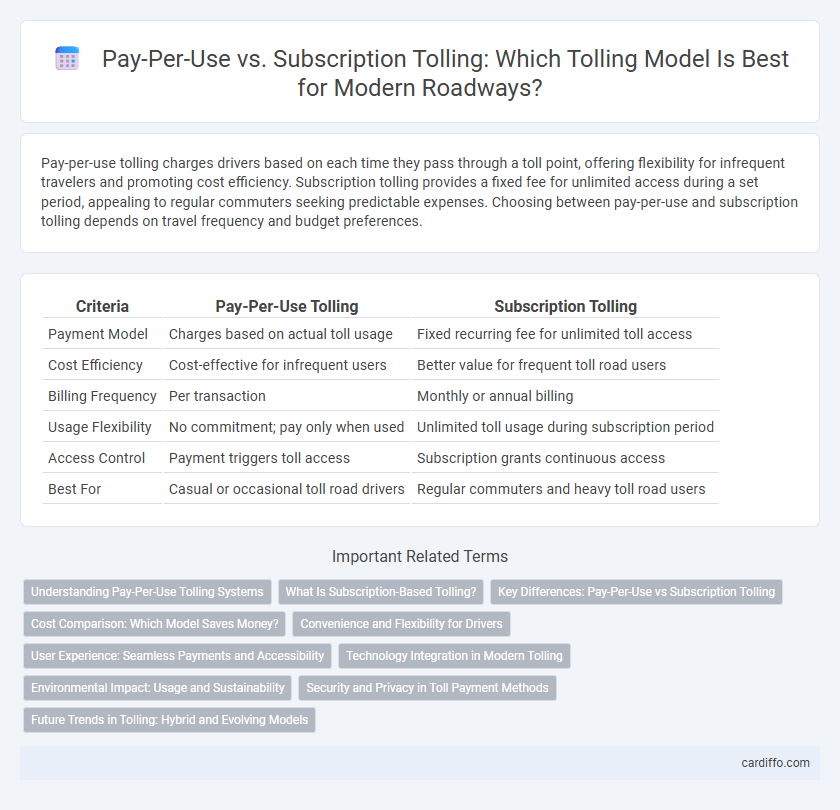Pay-per-use tolling charges drivers based on each time they pass through a toll point, offering flexibility for infrequent travelers and promoting cost efficiency. Subscription tolling provides a fixed fee for unlimited access during a set period, appealing to regular commuters seeking predictable expenses. Choosing between pay-per-use and subscription tolling depends on travel frequency and budget preferences.
Table of Comparison
| Criteria | Pay-Per-Use Tolling | Subscription Tolling |
|---|---|---|
| Payment Model | Charges based on actual toll usage | Fixed recurring fee for unlimited toll access |
| Cost Efficiency | Cost-effective for infrequent users | Better value for frequent toll road users |
| Billing Frequency | Per transaction | Monthly or annual billing |
| Usage Flexibility | No commitment; pay only when used | Unlimited toll usage during subscription period |
| Access Control | Payment triggers toll access | Subscription grants continuous access |
| Best For | Casual or occasional toll road drivers | Regular commuters and heavy toll road users |
Understanding Pay-Per-Use Tolling Systems
Pay-Per-Use tolling systems charge drivers based on the exact distance or segments traveled, leveraging real-time data from GPS or license plate recognition technologies to ensure accurate billing. This model offers financial transparency by aligning costs directly with road usage, reducing unnecessary expenses for infrequent travelers compared to flat subscription fees. Energy-efficient vehicle tracking and dynamic pricing algorithms further optimize revenue while encouraging sustainable driving behaviors.
What Is Subscription-Based Tolling?
Subscription-based tolling offers drivers a fixed fee plan granting unlimited or capped access to toll roads over a set period, contrasting with pay-per-use models that charge based on actual road usage. This approach enhances cost predictability and convenience for frequent travelers, often bundled with mobile app management and automatic payment processing. Major toll authorities implement subscription systems to improve traffic flow, reduce administrative costs, and deliver seamless digital toll experiences.
Key Differences: Pay-Per-Use vs Subscription Tolling
Pay-Per-Use tolling charges drivers based on the distance or number of trips made, offering flexible payment tied directly to road usage, while subscription tolling provides a fixed recurring fee for unlimited access within a specified period. Pay-Per-Use models cater to occasional travelers, minimizing upfront costs, whereas subscription plans benefit frequent commuters with predictable expenses and convenience. Both methods leverage electronic toll collection systems but differ significantly in cost structure, user commitment, and payment predictability.
Cost Comparison: Which Model Saves Money?
Pay-per-use tolling charges drivers solely based on actual road usage, making it cost-effective for infrequent travelers who avoid fixed fees. Subscription tolling involves a flat monthly or annual fee, beneficial for frequent commuters by offering predictable expenses and potential discounts on high mileage. Analyzing average toll costs shows pay-per-use saves money for low-distance users, while subscriptions minimize costs for regular, long-distance toll road users.
Convenience and Flexibility for Drivers
Pay-Per-Use tolling offers drivers maximum flexibility by charging only for the roads they use, eliminating the need for long-term commitments and enabling cost control based on actual travel patterns. Subscription tolling provides convenience through predictable monthly fees, simplifying budgeting and access to multiple toll routes without frequent payment processing. Both models enhance driver experience by catering to different preferences: Pay-Per-Use suits occasional travelers, while subscription plans benefit consistent commuters.
User Experience: Seamless Payments and Accessibility
Pay-Per-Use tolling enhances user experience by allowing drivers to pay only for actual road usage, eliminating the need for upfront fees and complex billing cycles. Subscription tolling offers consistent access with predictable monthly fees, often including benefits like reduced rates and automated payments for convenience. Both models prioritize seamless digital payment integration and real-time account management accessible via mobile apps, ensuring effortless toll transactions and improved accessibility for diverse user needs.
Technology Integration in Modern Tolling
Pay-Per-Use tolling leverages real-time data analytics and connected vehicle technology to charge drivers based on actual road usage, enhancing precision and transparency. Subscription tolling integrates IoT devices and cloud computing to offer fixed-rate access, simplifying payments and improving user experience. Advanced sensor networks and AI-driven platforms enable seamless technology integration, optimizing traffic management and revenue collection.
Environmental Impact: Usage and Sustainability
Pay-per-use tolling reduces unnecessary road usage by charging drivers only when they use toll roads, promoting more mindful travel and lowering vehicle emissions. Subscription tolling can encourage frequent use due to a fixed fee, potentially increasing traffic and carbon footprint, though it offers predictability for budget-conscious users. Optimizing tolling systems for environmental impact involves balancing fair pricing models with incentives that support sustainable transportation behaviors and reduce overall pollution.
Security and Privacy in Toll Payment Methods
Pay-Per-Use tolling offers enhanced privacy by charging users only when they pass through toll points, minimizing continuous tracking of travel patterns. Subscription tolling often requires the collection of extensive personal data and location information over time, increasing the risk of data breaches and unauthorized access. Implementing robust encryption and anonymization techniques is essential to safeguard sensitive user information in both toll payment methods.
Future Trends in Tolling: Hybrid and Evolving Models
Future trends in tolling emphasize hybrid models combining Pay-Per-Use and subscription options to enhance user flexibility and revenue predictability. Advanced data analytics and IoT technology enable dynamic pricing, adapting toll rates based on traffic patterns and individual usage behavior. These evolving models support sustainable infrastructure funding while improving user experience through customized payment plans.
Pay-Per-Use vs Subscription Tolling Infographic

 cardiffo.com
cardiffo.com